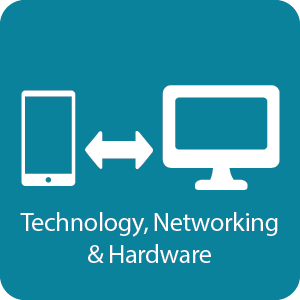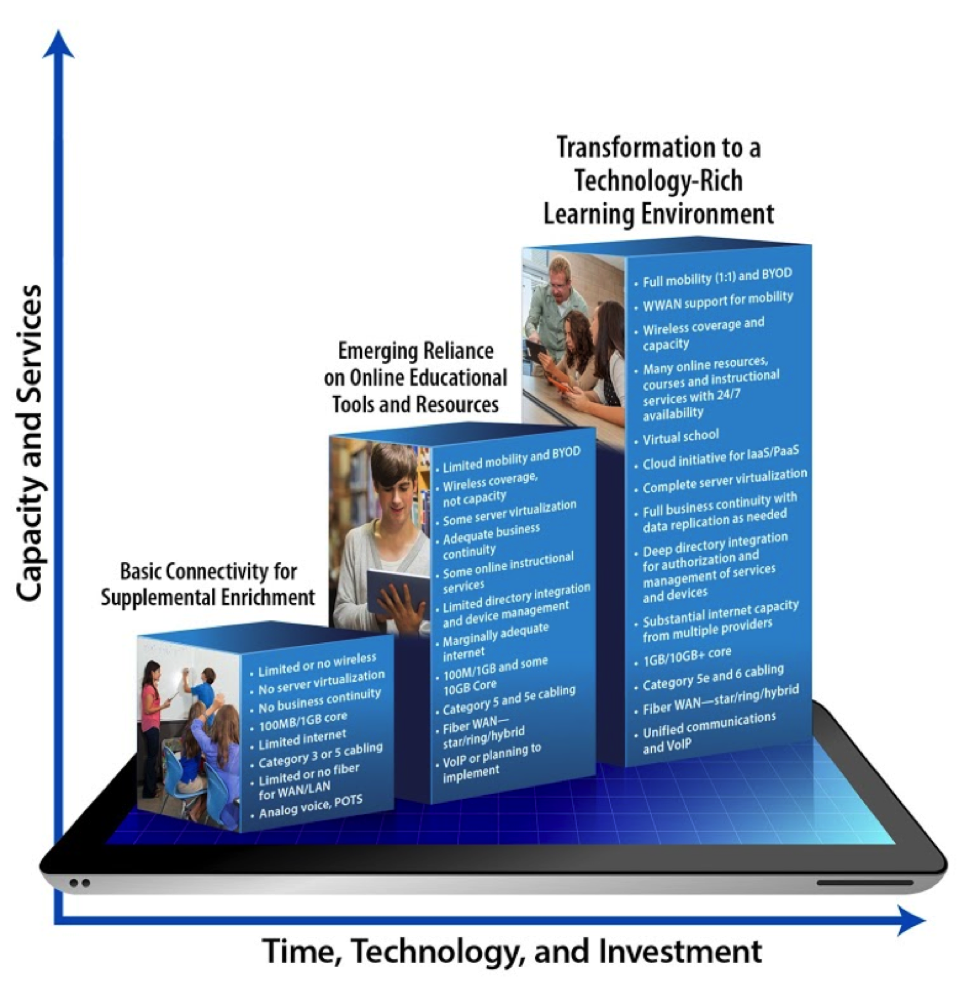Gear 2 - Introduction
The primary focus of the Wisconsin Digital Learning Plan is student learning. The emphasis of this section of the Plan is on the deployment of the systems critical to the success of all efforts toward student achievement. Those systems include student devices, digital content, networking hardware and software, bandwidth, service provider contracts, leadership, and technical training and support. Mobile computing has changed the way citizens live, work, learn, communicate, and play. Highly engaging digital learning environments are dependent upon a robust infrastructure.
When employed as part of a comprehensive educational strategy, the effective use of technology provides tools, resources, data, and supportive systems that increase teaching opportunities and promote efficiency.

Gear 2 is comprised of the the following Future Ready elements:
- Adequacy of Devices; Quality and Availability
- Robust Network Infrastructure
- Adequate and Responsive Support
- Formal Cycle for Review and Replacement
The Consortium for School Networking (CoSN) has created the graphic below to document the current state of technology adoption in a learning environment. Each district can self assess its current status and thoughtfully plan how and when it can move to the rich learning environment on the right. Making a transformational move of this type requires a clear mission, attainable goals, sustainable budgets, and constant re-assessment.

Gear 2 - Guiding Questions For Planning
- How do school districts create a digital learning environment with a sustainable, measurable impact on teaching and learning?
- How do school districts optimize the investment of technology dollars?
- How do school districts choose devices, networks, and software for implementation?
- What are the technology and hardware considerations when implementing a digital learning program?
- Data security
- Policies, including privacy
- Funding
- How do school districts reduce barriers students face without reliable Internet service at home, i.e. the “homework gap?”
- How can Wisconsin agencies ensure that Wisconsin students have access to a minimum of 1 Mbps of bandwidth to meet the State Educational Technology Directors Association (SETDA) and Federal Communications Commission (FCC) broadband standards?
2. Technology and Hardware Priorities
The Wisconsin Digital Learning Plan Goals, Recommendations, and Priority Activities within each section of the plan represent issues that speak to our engagement with federal, state, and local education agencies. Activities are targeted for completion by state education agency (SEA) and local education agency (LEA). In many cases, there will be collaboration between and among agencies to meet the goals.
GOAL 2.1
All school districts are able to meet student and staff bandwidth demand at all times throughout the school day.
RECOMMENDATION
Every school should implement SETDA benchmarks to ensure sufficient bandwidth to the edge of the building and develop an internal network and technical support sufficient to support student learning goals.
PRIORITY ACTIVITIES
- Work with national and state partners to ensure funding is available to meet bandwidth minimum speed of 1 Mbps at every school, to meet the 2017-2020 SETDA and FCC minimum broadband goals. Provide guidance for districts in identifying and implementing the most cost-effective Internet access and transport options. (SEA Target for Wisconsin DPI)
- Annually assess internal networks to ensure it is sufficient to support student learning goals. Develop network annually as needed, making use of E-rate and other available funding. (LEA Target for districts)
- Provide technical support sufficient to ensure student learning and staff work is not impeded by downtime. Explore providing internal staff, onsite support, and offsite network management. Make full use of E-rate Category 2 options for funding maintenance and network management. (LEA Target for districts)
GOAL 2.2
District leaders prepare comprehensive plans that document policies; publish current inventories; define upgrade and replacement schedules; identify annual budgets; and outline environmentally responsible disposal policies.
RECOMMENDATION
Assist school districts as they develop and redevelop infrastructure to support digital learning environments and district operations.
PRIORITY ACTIVITIES
- Establish formalized and working partnerships among DPI, other agencies and educational organizations, the private and nonprofit sectors to focus on resource acquisition to enable implementation of the recommendations. Specifically explore partnerships with the Board of Commissioners of Public Lands (BCPL), Department of Administration (DOA), Department of Enterprise Technology (DET), Public Service Commission (PSC), BadgerNet vendors, Education Superhighway (ESH) and others as appropriate for implementing local technology infrastructure improvements aligned to the this digital learning strategic plan. (SEA Target for Wisconsin DPI)
- Promote the use of the Future Ready Framework to guide school districts through the various phases of technology integration and management. (SEA Target for Wisconsin DPI)
- Routinely perform needs assessments and updates of integrated school library media and technology plans in alignment with broader district-level strategic planning using tools available through DPI or other sources. (LEA Target for districts)
- Assist school districts in the design of responsible use policies to meet the needs of new and expanding networks and services. (SEA Target for Wisconsin DPI)
- Create an annual summary of education technology funding options for districts to support technical guidance across various Wisconsin Department of Public Instruction divisions and teams and other state and federal agencies. (SEA Target for Wisconsin DPI)
GOAL 2.3
Funding for digital learning is integrated across multiple budget areas, including instruction, building facilities, technology, staffing, utilities, etc., where appropriate.
RECOMMENDATION
Assist districts in identifying viable funding sources for short and long-term technology purchases.
PRIORITY ACTIVITIES
- Provide state and regional training sessions to inform districts of new and existing funding opportunities such as the FCC’s Connect America Fund, new e-rate initiatives, Technology for Educational Achievement (TEACH), Wisconsin Public Service Commission (PSC) broadband expansion grants, the DOA BadgerNet, and others as they become available. (SEA Target for Wisconsin DPI)
- Create a working group of Wisconsin school districts and CESAs to advise the CESA Purchasing Consortium on potential digital learning purchasing opportunities to ensure all districts have equitable access to high-quality digital content, hardware and classroom resources. (SEA Target for Wisconsin DPI)
GOAL 2.4
School districts are able to strategically leverage their content and data assets across a number of systems and assemble solutions to integrate content and applications from a variety of sources and vendors.
RECOMMENDATION
Adopt technical interoperability standards in the following areas to ensure the seamless sharing of data content and services among systems and applications;
- Digital content
- Data connectivity
- Data integration
- Authentication, authorization and identity management
- Portals and portlets
- File sharing
- Network infrastructure
- Digital accessibility
PRIORITY ACTIVITIES
- Publish interoperability standards as technical assistance for school districts and share those through various communication channels including other stakeholders and partners. (SEA Target for Wisconsin DPI)
- Provide state and regional training sessions to inform districts of the interoperability standards and how those standards inform potential future purchases. (SEA Target for Wisconsin DPI)
GOAL 2.5
All school districts are able to address the need for school, community, and home access to ensure equity of digital resources to all students.
RECOMMENDATION
Participate in multi-agency efforts to provide broadband access for all homes in which PreK-12 students reside.
PRIORITY ACTIVITIES
- Create and continuously refresh a list of options available to families for establishing and affording Internet access at home. Promote this information through CESAs, school districts, and workshops. (SEA Target for Wisconsin DPI)
- Provide regional and state training on how school districts can work with community businesses and agencies to address the needs of broadband for all. (SEA Target for Wisconsin DPI)
- Collect data to determine levels of access across communities in Wisconsin and, where possible, build on systems currently in place. (LEA Target for districts)